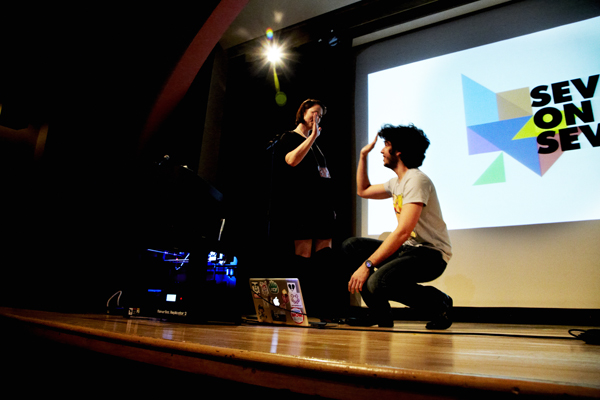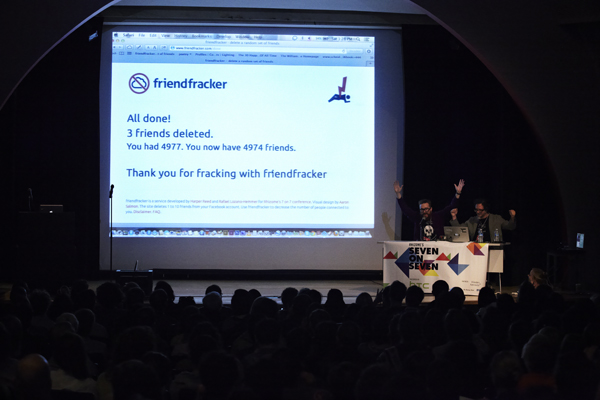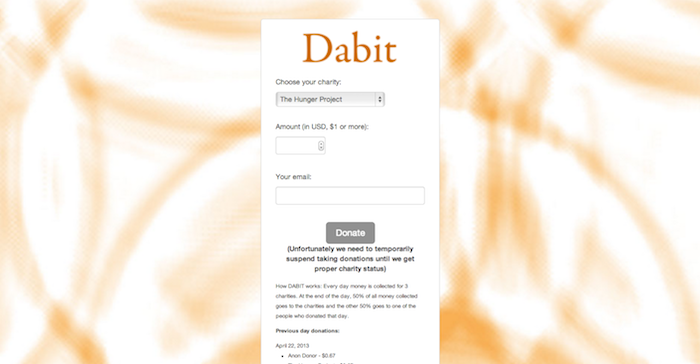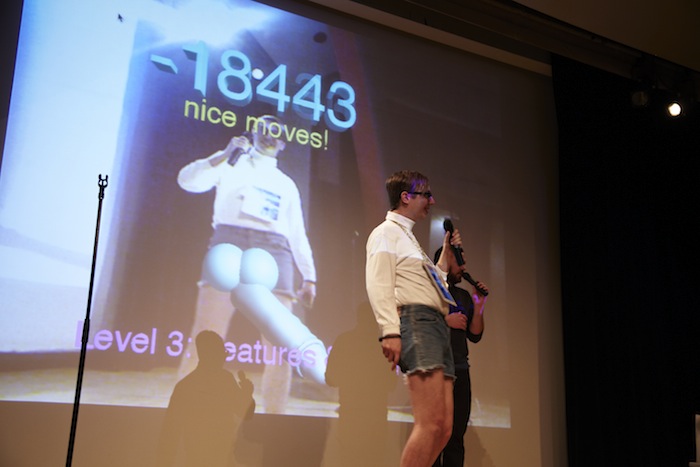This past Friday, seven artists and seven technologists, working in pairs assigned by Rhizome, took up residence in workspaces across the city. The rules of engagement were simple: they were given one day to make something, which would be made public the following day at Rhizome’s Seven on Seven conference, presented by HTC.
Seven on Seven can have the feel of an Olympic figure skating mixed pairs event in which the pairs have never met before. Part of the drama is around whether they hit the triple axel, so to speak: will their projects be any good? But there is another dimension to the drama as well, which has to do with the conversations and relationships that unfold on stage, the sparks that fly when two interesting minds come together.
What follows is a description of the projects, as well as the sparks, that came out of Saturday’s event.
KEYNOTE: EVGENY MOROZOV
Morozov has earned a reputation for having a sharp tongue as a result of his biting critiques of intellectual laziness in techno-culture. In his keynote, he struck a more diplomatic note, re-affirming his belief in the importance of technology: "The message, especially in my book that just came out, is that technology is very powerful." He emphasized the importance of looking at the histories of art and technology history in tandem, as a way of understanding the origins of old ideas that are packaged as new solutions. In particular, he called on artists to create friction and complexity where technologists offer oversimplified solutions.
As the conference continued, it became increasingly clear that there are technologists out there who do have a keen understanding of the complexity of their field. One of these, without a doubt, is Alex Chung, who presented in the leadoff slot with artist Paul Pfeiffer.

Animated GIF extracted from Giphnosis (2013). Website with downloadable screensavers.
1. PAUL PFEIFFER + ALEX CHUNG
Pfeiffer and Chung's project Giphnosis is a website offering two downloadable screensavers, each comprising a series of tiled animated GIFs. One features a fragment of The Shining: aquaking Shelley Duvall in the corridor of Overlook Hotel, wielding a large knife. The other stars an ensemble of five cats who look to the left, the right, up and straight into the camera, in perfect synch.
Pfeiffer and Chung clearly came into this collaboration with shared interests. Both use moving image media as a kind of database of shared raw materials; Pfeiffer subjects his source material to digital manipulations, while Chung’s startup Giphy allows users to find looped, animated images on the Web. Their presentation was rich with ideas, including a comparison between Marcel Duchamp’s Anemic Cinema (1926) and the animated GIF file format, as well as the revelation that Giphy was inspired by Chung’s interest in Wittgenstein.
In particular, Pfeiffer and Chung found a shared fascination in the idea of the loop. In an effort to determine why this cultural form holds so much power over our minds, they turned to the idea of hypnosis, reasoning that the constant repetition of media imagery in the age of the 24-hour news cycle has a kind of hypnotic effect on viewers. By offering their own looping imagery, Pfeiffer and Chung position Giphnosis as an act of resistance against this type of media bombardment. In a kind of self-administered experiment, it might be used to re-program one’s mind through exposure to looping images.
It might also be the beginning of a beautiful friendship.
Constant Update (2013). Single-channel video with sound.
2. FATIMA AL QADIRI + DALTON CALDWELL
For their contribution to Seven on Seven, Al Qadiri and Caldwell created a video work with an original musical composition. White words appear against a black background, one after another: “Constant... Continual… Dread.” On the soundtrack, a steady stream of digital alerts play over a steadily building rhythm. The effect is hypnotic and anxiety-inducing in equal measures.
In the "About" section of the project website, Al Qadiri and Caldwell describe the video as "a work dedicated to the exploration of data-related anxiety. The rate of updates and notifications required of society, from media outlets to social networks, is stressful to say the least…This site will never be updated."
Al Qadiri and Caldwell used the term "infobesity" to describe the feeling of bloating that comes from indulging in an excess of information. Both clearly had strong feelings on the matter; a which can be seen in their past work: Caldwell is the founder of a tech company that launched an ad-free social network, App.net, while Al Qadiri often appropriates technological content, such as beats drawn from videogames, and turns it against itself. This message of data desaturation may seem incongruous for an art and tech conference, but Constant Update likely inspired many in the audience to turn off their glowing LED screens—for a short time, at the very least.

Audience volunteer Diego high-fives technologist Tara Tiger Brown after designing and printing his first 3D model based on instructions from the audience. Photo by Jesse Untracht-Oakner.
3. CAMERON MARTIN + TARA TIGER BROWN
Martin, a self-taught artist and musician, and Tara Tiger Brown, maven of maker culture, found a common ground in their shared passion for informal education. During their daylong collaboration, they decided to teach themselves a new skill: 3D modeling and printing. They set out to make a model of a balloon dog à la Jeff Koons; the results were amateurish, but endearingly so.
Building on this experience, Martin and Brown devised an experiment to conduct on stage at Seven on Seven. They asked for a volunteer from the audience with no prior knowledge of 3D modeling or printing, and invited a man named Diego onto the stage. Members of the audience (many of whom presumably know a great deal about 3D modeling) were asked to guide Diego through the process of making and printing a simple model by posting messages to Twitter using the hashtag #3DHelper.
The signal-to-noise ratio on the Twitter hashtag was quite low, and soon the experts in the audience were shouting their advice directly to Diego, allowing him to successfully fabricate a small 3D-printed badge with his name on it. Even if the hashtag proved not to be quite the right tool for the job, the broader point was made: informal and collective pedagogical models can be both generative and fun.
But even if Twitter didn’t pan out perfectly as a collaborative tool, it was an important part of the experiment. At a time when educational institutions are rushing to add paid online courses to their curricula, the use of network technology to support a more collective model of learning can be seen as an act of resistance with profound political implications.

Rafael Lozano-Hemmer and Harper Reed demonstrating friendfracker (2013). Online service for use with existing Facebook accounts.
4. RAFAEL LOZANO-HEMMER AND HARPER REED
With the online service friendfracker, users of the popular social networking website Facebook can slightly reduce their overall number of “friends,” or people with whom they are connected on the site. When users log into the service using their Facebook account, friendfracker will randomly delete some of their “friends.” A message appears onscreen informing the user how many friends have been deleted (a randomly selected quantity, between 1 and 10), but they are not informed which friends have been deleted.
Lozano-Hemmer and Reed embarked on their collaboration with a shared interest in collecting personal data. Reed confessed that he often collects a lot of data about himself for “no reason,” saying that “it might be important someday.” As Giampaolo Bianconi observed in Rhizome’s liveblog of Seven on Seven, the duo “asked one of the most asked questions of our time: what do we do with all this data?”
From their shared interest in data, Lozano-Hemmer and Reed (echoing Al Qadiri and Caldwell) moved on to the topic of erasure. In their presentation, they offered examples of erasure that included artworks (Robert Rauschenberg’s Erased Willem de Kooning Drawing) and technology projects (Snapchat, in which users can send messages to one another that automatically self-destruct after a pre-determined amount of time).
But what makes friendfracker so compelling is not just that it is an act of erasure. Self-erasure online has many precedents: in 2005, Cory Arcangel deleted his Friendster account in front of a live audience in a performance titled Friendster Suicide, while Giphy founder and Seven on Seven participant Alex Chung has gone to great lengths to erase himself from the Web. friendfracker offers something else: it injects uncertainty into one’s online social life. Because any of one’s “friends” may be deleted, it asks users to rethink the importance they place on their online social connections.

Screenshot of Dabit (2013). Online lottery and charitable donation service.
5. MATTHEW RITCHIE AND BILLY CHASEN
Dabit is a platform that uses humans’ inherent irrationality with regard to lotteries as a way of driving charitable donations. The site collects contributions for a list of pre-selected charitable foundations; 50% of each donation goes to the charity of the donor’s choice, while the other 50% goes into a kitty. At midnight each day, the kitty is paid out to one of the donors from the day.
After what must have been a fairly heroic coding effort by Chasen, and a less heroic beer-drinking and logo design effort on the part of Ritchie, the site went live at Seven on Seven—although it has since been taken down while its organizational status is formalized. By the end of Ritchie and Chasen’s presentation, $953 had been raised. According to the website, $471 was paid out at midnight to an anonymous donor.
For Ritchie and Chasen, the project emerged out of the idea that Seven on Seven participants often view technology as a way of cultivating "good" behaviors. As Ritchie put it, Dabit "appeals to both the best and the worst." As with any lottery, the house (in this case, the charities) always comes out on top. It is possible to “game” the system by making a very small contribution in hopes of winning a big prize, but the pair decided to allow this kind of behavior; they see the money paid to individual winners as a form of charity as well.

Jeremy Bailey demonstrates “Big Penis Mode” at Seven on Seven 2013. Photo by Jesse Untracht-Oakner.
6. JEREMY BAILEY + JULIE UHRMAN
Bailey and Uhrman's project turned attention to the presentation itself as a cultural form in need of reinvention. Taking the approach that presentations can be thought of as a kind of game, they developed a system that allows presenters to earn points for moving about dynamically onstage, for earning Twitter comments, for being loud or for earning applause. The game is a basic augmented reality system, with the typical PowerPoint deck replaced onscreen (TEDTalk style) by a video image of the presenter overlaid with text and graphics, such as a score that hangs above their head, showering them with coins when they earn a reward.
Following a pitch by Uhrman that felt at times like a stand-up routine (she explained that her common ground with Bailey was a shared narcissism and desire to “win” Seven on Seven), Bailey (clad in rather revealing cut-off shorts) demonstrated the project, moving manically about the stage and throwing glowsticks to the audience while keeping up a high-energy, high-volume commentary in order to earn the highest possible score. He also revealed that he’d been up all night working on the project, which is not surprising—it had no shortage of bells and whistles, with networked data, live video and real-time 3D graphics, and it worked without a hitch.
The show-stopping moment, though, was when Bailey and Uhrman invited moderator John Michael Boling to present the last feature of the project. As a way of boosting the presenter’s confidence, their system includes "big penis mode," which superimposes a 3D animated penis over a presenter as they move about the stage. (It really loses something in the telling. Just look at the picture.) Boling handled this with supreme aplomb as the audience broke down in laughter, observing that "Google Image search results for me are going to be bad."
"Big Penis Mode," while hilarious, does warrant some serious thought: why, when we try to invoke confidence and power, do we always have to rely on the male symbols we inherit from a patriarchal society? It’s certainly not Bailey and Uhrman’s fault that the big penis plays the role that it does in our cultural lexicon; their project could even be seen as a satire of this. The big penis certainly looks ridiculous. Still, it’s a question that could be thematized in future versions of Bailey and Uhrman’s project – once Bailey manages to catch up on his sleep.
7. JILL MAGID AND DENNIS CROWLEY
Crowley had a difficult week; after a close shave at the Boston Marathon (he was several miles from the finish when the bombing took place), he came down with a 24-hour virus on the allocated one day for collaboration. Still, he and Magid gamely continued to talk via Skype as much as possible, presenting their project at the conference as a dialogue rather than a finished work.
What was immediately clear from their conversation was that the two had a great deal in common. A former student of NYU’s ITP program, Crowley is the co-creator of projects such as Pac Manhattan, a real-life version of the iconic videogame played in the city streets, as well as the location-based social networking platforms Dodgeball and Foursquare. Magid is a contemporary artist who has won acclaim for embedding herself in systems of surveillance and power, from CCTV operators in Liverpool, England to the Dutch Secret Service. As a result, they have a shared interest in individuals’ relationship with the wider systems that surround them. If they had time to make a project, it might have been something that makes visible the workings of these systems, something like Bruce Nauman’s Performance Corridor for the technologically-mediated city.
It also became clear, though, that there were important differences in their respective approaches. Crowley is a founder of social networking sites, Magid is a social networking refusenik. Crowley builds systems and collects data that might (someday, somehow) be useful, whereas Magid is interested in the aspects of systems where they begin to break down, uncovering the human drives that run throughout seemingly rational, impersonal systems. At one point in the discussion, Crowley shared that he often collects data that he has no known use for, such as the output of a heart-monitoring device. In a moment that recalled Christian Nold’s project Bio Mapping, he recounted looking back at his data at one point, suddenly realizing that his heartrate had spiked during his purchase of an engagement ring. For Magid, this represented a moment of beauty within a seemingly impersonal data stream. “You should give a data visualization of your heartrate to your fiancée,” she suggested. “It’s so much more beautiful than a photograph.”